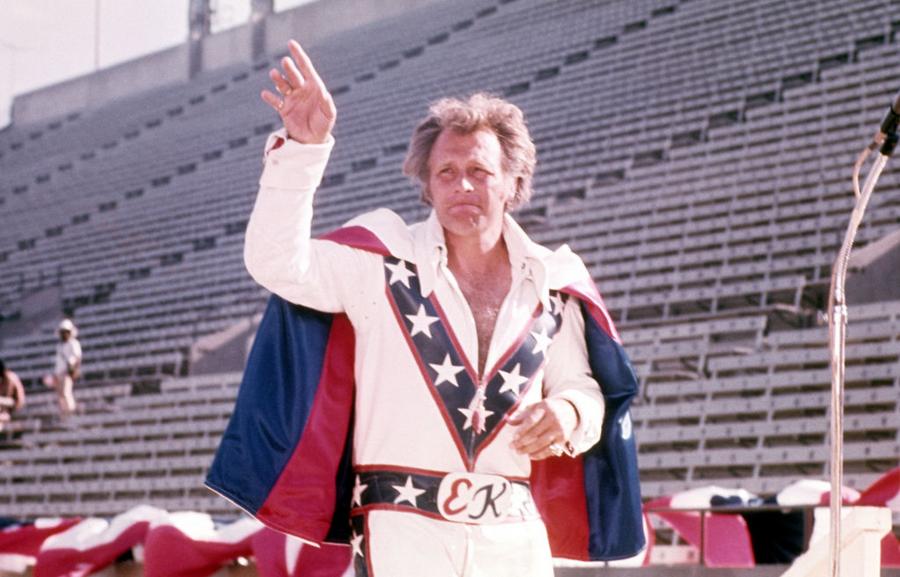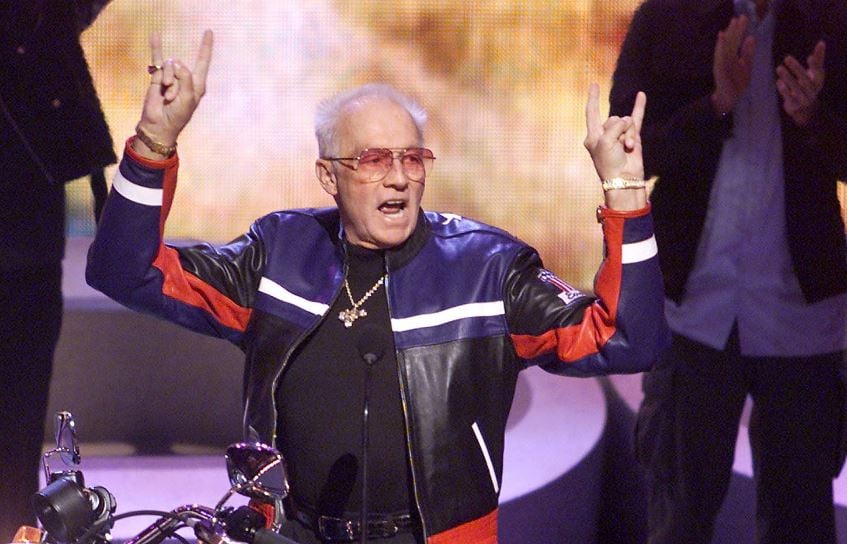What Is Evel Knievel's Net Worth?
Evel Knievel was an American daredevil motorcyclist, painter, and entertainer who had a net worth of $3 million at the time of his death in 2007.
Robert "Evel" Knievel was America's most famous daredevil. He rose to fame in the 1960s and 1970s with his death-defying motorcycle stunts. Born in Butte, Montana in 1938, Knievel first gained attention after a police chase led to his "Evel" nickname. After working as an insurance salesman, he launched his daredevil career in 1965, performing motorcycle jumps that grew increasingly spectacular and dangerous.
Knievel's signature red, white, and blue leather jumpsuit and cape became iconic as he toured the country, attempting to jump over cars, buses, animals, and even the fountains at Caesars Palace in Las Vegas. His legendary Snake River Canyon rocket jump attempt in 1974 was watched by millions despite ending in failure when his parachute deployed prematurely.
Throughout his career, Knievel suffered more than 433 bone fractures and became famous not just for his successes but for his spectacular crashes. His showmanship and fearlessness made him a cultural phenomenon with merchandise, toys, and even a Hollywood film about his life.
By the time he retired in 1980, Knievel had cemented his legacy as the world's greatest motorcycle daredevil. He passed away in 2007 at age 69.
Most Insane Career Stunts
- Caesars Palace fountain jump (1967): Crashed upon landing, spent 29 days in a coma with a crushed pelvis and femur
- 19 cars jump at Ontario Motor Speedway (1971): Successfully cleared 19 cars side by side
- Snake River Canyon rocket jump (1974): Attempted to cross quarter-mile wide canyon in a steam-powered rocket; parachute deployed prematurely
- 14 Greyhound buses jump at Kings Island (1975): Successfully cleared all buses, setting a world record
- 13 double-decker buses jump at Wembley Stadium (1975): Crashed upon landing, breaking his pelvis
- Shark jump at Chicago International Amphitheatre (1976): Jumped over a tank containing 13 sharks
- 10 Mack trucks jump (1974): Cleared the trucks at Dragway 42 in Ohio
Early Life and Career Beginnings
Evel Knievel was born Robert Craig Knievel on October 17, 1938, in Butte, Montana. He was the first of two children of Ann Marie and Robert E. Knieval, who were of Irish and German ancestry, respectively. When their parents divorced in 1940, Evel and his brother Nic were raised by their paternal grandparents. As a teenager, Knievel attended Butte High School but left after his second year. He subsequently landed a job as a diamond drill operator for the Anaconda Mining Company, working in the copper mines. Eventually, Evel was promoted to surface duty but was fired when he did a wheelie on the earth mover he drove and took out Butte's main power line in the process.
A lifelong thrill-seeker, Knievel entered into many local ski jumping events and professional rodeos and won championships along the way. In the late '50s, he joined the United States Army and was a pole vaulter on the track team. He also tried out with the Eastern Hockey League's Charlotte Clippers but decided against being on a traveling team. After having his first child, Evel started the Sur-Kill Guide Service, a hunting service, to help support his family. In 1961, he hitchhiked from Butte to Washington, D.C., to raise awareness about the harmful culling of elk in Yellowstone. Upon his return home, he joined the motocross circuit and ended up breaking his collarbone and shoulder. A career change led to him selling insurance, at which he was successful.
First Stunt Performances
When the insurance company he worked for refused to promote him to vice president, Knievel quit his job. He subsequently moved with his family to Moses Lake, Washington, where he opened a Honda motorcycle dealership. After the dealership closed due to the difficulty of selling Japanese imports, Evel went to Sunnyside, Washington, to work at Don Pomeroy's motorcycle shop. It was Jim Pomeroy, Don's son, who taught Knievel how to do a wheelie while standing on the seat of his bike.
Inspired by a Joie Chitwood daredevil auto show he had seen as a youth, Evel set up his own stunt show with his motorcycle. He performed a few wheelies and then jumped over a 20-foot-long box of rattlesnakes, plus a pair of mountain lions. In order to make more money, Knievel partnered with sponsor Bob Blair, the owner of ZDS Motors, Inc. and distributor for Norton Motorcycles. In January 1966, Evel debuted with his team of daredevils at the National Date Festival in Indio, California. A massive success, Knievel went on to book subsequent shows in Hemet and Barstow and then went from town to town as a solo act. He began jumping cars in addition to motorcycles and suffered a major injury after a particularly large jump attempt in Missoula, Montana. After recovering, he cleared 15 cars in Gardena, California, but then weathered more serious injuries in Graham, Washington. In 1968, Evel achieved national exposure when he appeared on "The Joey Bishop Show."

(Photo by Michael Ochs Archives/Getty Images)
Major Jumps
One of Knievel's first majorly publicized jumps was at Caesars Palace in 1967, where he attempted to clear 141 feet over the fountains; it was his longest-ever motorcycle jump attempt. He ended up crashing and suffered injuries that kept him in the hospital for weeks. The crash and recovery and the televised footage of the jump made Evel more famous than ever. He subsequently attempted to jump 15 Ford Mustangs in Scottsdale, Arizona, but crashed again. However, from August to October 1968, Knievel was landing successful jumps almost every week.
In 1971, Evel set a world record by jumping over 19 cars in Ontario, California. Although he had planned to jump the Grand Canyon, he knew the government would strictly forbid it. Instead, he focused on jumping Idaho's Snake River Canyon, which he attempted in 1974. The next year, he did more motorcycle jumps on ABC's "Wide World of Sports," including attempts at London's Wembley Stadium, King Island in Ohio, and the Seattle Kingdome. After an aborted jump over a tank of live sharks in Chicago in 1977, Knievel retired from major performances.

Getty
Post-Performance Years
Following his last stunt show in 1980, Knievel made appearances at smaller venues to help foster the career of his son, Robbie. He served as Robbie's touring companion for a while, making his last on-tour appearance in Hollywood, Florida, in 1981. For the remainder of the decade, Evel drove across the country selling works of art he allegedly created. In the '90s, he helped market brands such as Harley-Davidson, Little Caesars, and Maxim Casino.
In 2003, Knievel signed over rights to composer Jef Bek to make a rock opera based on his life. In 2005, Evel promoted his last "ride" at the Harley-Davidson dealership in Milwaukee, to benefit victims of Hurricane Katrina. Due to suffering a mild stroke, he never actually rode.
Personal Life and Health Struggles
Knievel married Linda Joan Bork in 1959, and they had four children, Kelly, Robbie Knievel, Tracey, and Alicia. The pair separated in the early '90s before divorcing in 1997. In 1999, Evel married Krystal Kennedy, whom he later divorced in 2001.
In the late '90s, Knievel received a life-saving liver transplant while suffering from Hepatitis C. In 2005, he was diagnosed with a terminal lung disease that required him to be on a supplemental oxygen supply 24/7. That year, he also had two minor strokes. On November 30, 2007, Evel passed away at his residence in Clearwater, Florida.
/2021/05/Evel-Knievel.jpg)
/2013/10/robbie-e1621527527402.jpg)
/2010/07/Travis-Pastrana.jpg)
/2014/12/GettyImages-630378106.jpg)
/2013/06/Nik-Wallenda-1.jpg)
/2020/02/johnny-knoxville.jpg)
/2021/10/John-Boyega.jpg)
/2010/11/josh.jpg)
/2022/05/Nayib-Bukele.jpg)
/2010/11/russell-armstrong.png)
/2013/07/courtney-henggeler.jpg)
/2021/12/Lauren-Sanchez.jpg)
/2020/10/cate.jpg)
/2018/04/GettyImages-942450576.jpg)
/2021/08/bert-kreisher.jpg)
/2021/09/tom-segura.jpg)
/2023/09/john-mars.png)
/2021/05/Evel-Knievel.jpg)
/2013/10/robbie-e1621527527402.jpg)
/2018/08/Seth-Enslow.jpg)
/2020/10/Linda-Evans.jpg)
/2010/12/Carey-Hart.jpg)
/2009/10/Bill-France-Jr..jpg)
/2010/07/James-Bubba-Stewart-1.jpg)